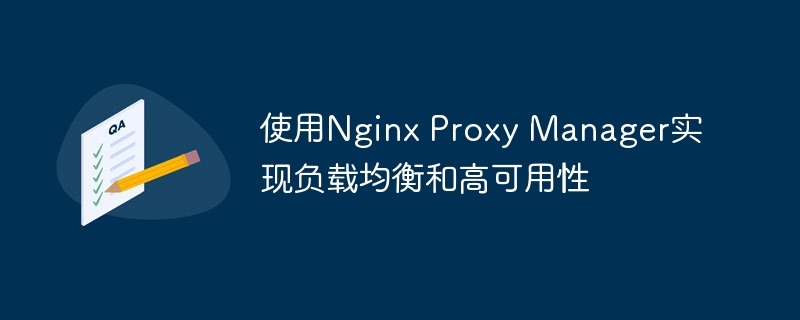Home >Operation and Maintenance >Nginx >Use Nginx Proxy Manager for load balancing and high availability
Use Nginx Proxy Manager for load balancing and high availability
- PHPzOriginal
- 2023-09-26 16:41:091348browse

Use Nginx Proxy Manager to achieve load balancing and high availability
Introduction:
In modern Internet applications, load balancing and high availability are very important factors . Load balancing ensures that requests are evenly distributed across multiple servers, thereby improving application performance and scalability. High availability ensures that even if one of the servers fails, the application can still run normally. In this article, we will introduce how to use Nginx Proxy Manager to achieve load balancing and high availability.
Nginx Proxy Manager is an open source tool based on Nginx and Docker, which can easily set up and manage Nginx reverse proxy server and provide load balancing and high availability functions. It provides a friendly web interface that allows users to configure and manage it easily. Next, we will step by step introduce how to use Nginx Proxy Manager to achieve load balancing and high availability.
Step 1: Install Docker and Docker Compose
Before we begin, we need to install Docker and Docker Compose. Docker helps us easily create and manage containerized applications, while Docker Compose enables us to define and manage multiple containerized applications in a declarative manner.
Step 2: Install Nginx Proxy Manager
Clone Nginx Proxy Manager from the official GitHub repository using the following command:
$ git clone https://github.com/jc21/nginx-proxy-manager.git
Go to the cloned directory and run the following command to create the configuration file:
$ cd nginx-proxy-manager $ cp .env.sample .env
Edit the .env file and set the required configuration parameters. For example, set the domain name and port:
DOMAIN_NAME=mydomain.com HTTP_PORT=80 HTTPS_PORT=443
Save and close the .env file. Next, run the following command to start Nginx Proxy Manager:
$ docker-compose up -d
Step 3: Set up load balancing
Access the web interface of Nginx Proxy Manager through a browser, and in the settings page, select "Backend Server" , then click the "Add Backend Server" button. On the Add Backend Server page, fill in the server name and server IP address, and save the settings.
In the "Virtual Hosts" tab of the settings page, configure your backend server and load balancing options. Select "Reverse Proxy Type" as "Load Balancing", and then select your favorite load balancing strategy, such as round robin, weight, IP hash, etc.
After saving the settings, Nginx Proxy Manager will automatically create a load balancing configuration for you and distribute traffic to the specified backend server.
Step 4: Set up high availability
To set up high availability, we need at least two backend servers. On the backend server settings page, click the "Add backend server" button, and then add a second server. Make sure the IP addresses of the two servers are different.
In the "Virtual Host" tab of the settings page, select "Reverse Proxy Type" as "High Availability". Then select your two backend servers and save the settings.
This will automatically create a high availability configuration for you. If one of the servers is unavailable, Nginx Proxy Manager will automatically redirect the request to another available server.
Conclusion:
By using Nginx Proxy Manager, we can easily achieve load balancing and high availability, improving application performance and scalability. It provides a simple and easy-to-use interface that allows us to easily set up and manage reverse proxy servers. The above steps provide detailed instructions to help readers quickly get started using Nginx Proxy Manager.
The above is the detailed content of Use Nginx Proxy Manager for load balancing and high availability. For more information, please follow other related articles on the PHP Chinese website!
Related articles
See more- What does nginx load balancing mean?
- Memcached caching technology supports high availability of PHP applications
- MySql high availability and disaster recovery: how to ensure the stable operation of the database
- Use MySQL in Go language to manage high-availability cluster data
- Compatibility optimization between Nginx Proxy Manager and HTTP/2 protocol

